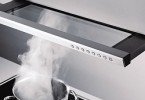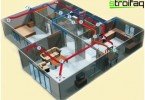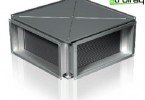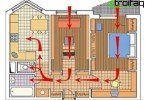Basement and cellar ventilation of a private house
The efficient use of cellars and cellars is impossible without normalizing the temperature and humidity parameters of the air, because insufficient air exchange increases humidity, which leads to damage to the ceiling and walls by fungus, and also negatively affects the safety of the vegetable supply and home preservation, which are usually filled with cellars and cellars. Properly arranged garage ventilation with a cellar will help prevent premature corrosion of the car body. High-quality ventilation of the basement of a private house will make it possible to make the previously uninhabited area quite suitable for further arrangement under the workshop, gym or pantry. Today we consider in more detail information on how to make ventilation in the cellar, in the basement of a garage or a private house. A common understanding of the essence of the processes will be the impetus for the practical application of the information received, which ultimately will allow rational use of the usable area.
Content
- Cellar ventilation features
- Basement Features
- Option with supply and exhaust duct
- Forced way
- Using an automated system
Cellar ventilation features
As mentioned above, effective ventilation of the basement in the garage is one of the necessary conditions for the preservation of the car, but only the technical aspect of the destruction of iron during a long stay in a high humidity environment is considered here. Much more important is the fact that a high concentration in the air of fumes of fuels and lubricants, fuel combustion products (exhaust gases) can be hazardous to health. Therefore, it is necessary to choose the most effective ventilation device in the basement from all possible options, taking into account, of course, economic feasibility.
Basement Features
Thus, a mechanical ventilation device in a basement can be very costly. The use of a natural ventilation arrangement based on the principle of natural air recirculation is preferable in technical rooms. To implement such a ventilation system, a device for exhaust and supply ducts is necessary. The inlet of the exhaust duct must be under the ceiling, and the supply air in the opposite corner of the room, as close to the wall as possible, at a height of 0.5 m from the floor.
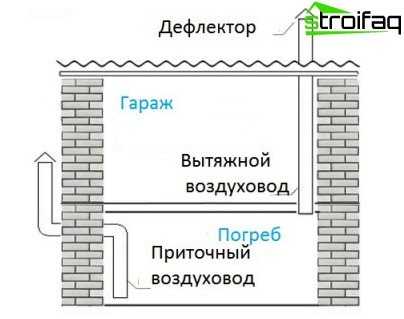
To ensure optimal traction, the location of the outlet of the supply air duct should be significantly lower than the exhaust
Such placement will ensure optimal air circulation. Through the supply air duct, a stream of fresh air enters the storage and displaces the exhaust air. Contaminated air is removed naturally through an exhaust duct. The speed of air flow through the channels directly depends on the height of the exhaust channel and the temperature difference inside the basement and on the street. The height of the ventilation exhaust pipe should be higher than the level of the roof or roof ridge, only then the exhaust air outlet will be effective. For obvious reasons, it is imperative that the duct outlet be equipped with a protective visor or deflector. If it is technically possible to lay an air duct near the smoke channel of a heating boiler or fireplace, be sure to use it – such an arrangement will increase traction in the exhaust channel (due to additional heating). It is advisable to supply both ducts with special flaps to prevent possible freezing of the storage in severe frosts.
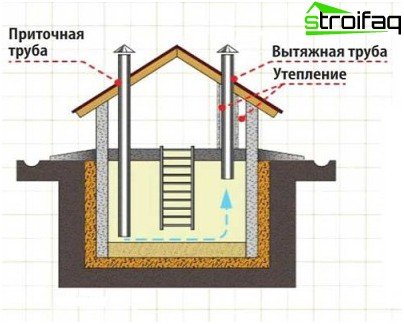
Part of the duct passing through the attic must be insulated.
Option with supply and exhaust duct
For a small storage volume, you can use a somewhat simplified, so to speak, design. The supply and exhaust duct is designed to supply fresh air and remove the exhaust using a single wooden structure containing both the supply and exhaust duct. The simplified ventilation scheme of the cellar in this case ensures the capture of a very small amount of air for air exchange.
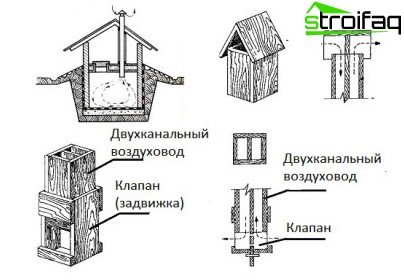
The diagram clearly shows the method of supply and exhaust ventilation with a two-channel duct with a valve for adjusting draft
It is also possible ventilation in the cellar without a supply air duct. In this case, air will flow through various slots, leaks.
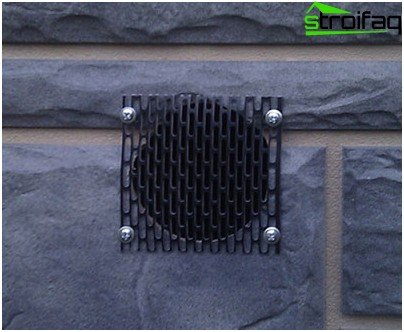
If the basement is slightly above ground level, then air supply through specially designed products (necessarily equipped with rodent grilles) will be the best option.
Forced way
The main disadvantage of natural ventilation is its dependence on weather conditions, for example, in winter, ventilation is most effective due to the large temperature difference, it can even be said to be excessively effective, so for the winter it is necessary to close the air ducts used for air flow to prevent freezing of the basement. In the summer, due to a small temperature difference, natural ventilation may not be sufficient to organize optimal air exchange. Proper ventilation of the cellar should include temporary air exchange difficulties. It is possible to improve the above ventilation scheme through additional equipment of the exhaust duct with a fan. It is undesirable to equip the supply duct with a fan for continuous operation, because the intensive injection of the supply air with insufficient exhaust duct efficiency will contribute to blowing out contaminated air through various leaks and gaps.
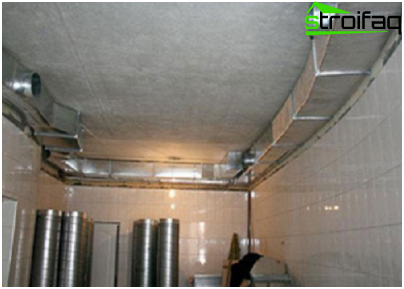
Forced ventilation is required in the basement, which is used to equip the recreation area
The combined ventilation scheme is used when it is necessary to quickly drain the basement. Installing an electric fan in the lumen of the supply air duct opening will allow to speed up the air exchange to the desired values during the period when natural ventilation is ineffective. Intensive air discharge with the open access hatch and, of course, the open damper of the exhaust duct will provide quick drying of the room with high humidity on fine hot days. Installing fans in both the supply and exhaust ducts makes sense for the device for air exchange in rooms with a large area. The operation of such a ventilation system will require significant energy consumption. As you can see, ventilation in the basement with your own hands can be arranged quite efficiently only with an understanding of the essence of the processes and a thorough study of the issue.
Using an automated system
A wine cellar should be ventilated while maintaining the stability of temperature and humidity, which is technically possible only if high-quality climate technology is used. Thoughts on how to make ventilation in the basement “little blood” can be realized in an irresponsible decision to circumvent the need to develop technical requirements for the preparation of the room. The subtleties of miscalculating the loads on the power output points, the ratio of the serviced area with the required equipment capacity, and other subtleties of the preparatory work seem insignificant. Meanwhile, only highly qualified installation can provide the necessary climate stability. Do-it-yourself ventilation in the cellar can be done, but only with proper preparation and careful study of the issue. If it is necessary to install a split system (to maintain the stability of climate parameters), it is better to use the help of highly qualified specialists.


